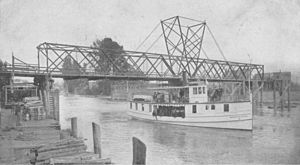Snohomish, Washington facts for kids
Quick facts for kids
Snohomish
|
|
|---|---|
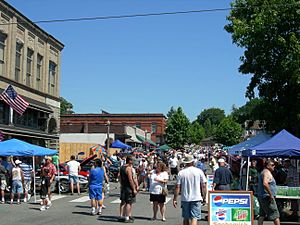
First Street during the annual Kla-Ha-Ya Days celebration, 2006
|
|
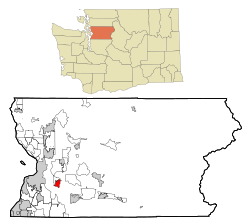 |
|
| Country | United States |
| State | Washington |
| County | Snohomish |
| Founded | 1859 |
| Incorporated | June 26, 1890 |
| Government | |
| • Type | Mayor–council |
| Area | |
| • Total | 3.72 sq mi (9.64 km2) |
| • Land | 3.52 sq mi (9.12 km2) |
| • Water | 0.20 sq mi (0.52 km2) 5.37% |
| Elevation | 66 ft (20 m) |
| Population
(2020)
|
|
| • Total | 10,126 |
| • Estimate
(2022)
|
10,150 |
| • Density | 2,875.9/sq mi (1,110.4/km2) |
| Time zone | UTC−8 (PST) |
| • Summer (DST) | UTC−7 (PDT) |
| ZIP Codes |
98290–98291, 98296
|
| Area code | 360 |
| FIPS code | 53-65170 |
| GNIS feature ID | 1531910 |
Snohomish is a city in Snohomish County, Washington, United States. In 2020, about 10,126 people lived there. The city is located on the Snohomish River, between Everett and Monroe. It sits where U.S. Route 2 and State Route 9 meet. Snohomish also has a small airport called Harvey Airfield, mainly used for private planes.
The city was started in 1859 and was first called Cadyville. It was named after an early settler, E. F. Cady. In 1871, its name changed to Snohomish. From 1861 to 1897, Snohomish was the main government center for Snohomish County. Today, downtown Snohomish is famous for its many antique shops. This area is also listed on the National Register of Historic Places because of its historical importance.
Contents
History of Snohomish
Early Days and Native People
The Snohomish River Valley was originally home to the Snohomish people. They were a Coast Salish tribe living between Port Gardner Bay and what is now Monroe. Old sites near the Snohomish and Pilchuck Rivers show people lived there as far back as 8,000 years ago. A village called sbadaʔɬ was located where the city is now. The Snohomish people met white explorers in the early 1800s. Their name was written as "Sinnahamis" by John Work. In 1855, the Snohomish signed the Point Elliott Treaty. This treaty moved the tribe to the Tulalip Indian Reservation.
Founding the City
In the early 1850s, the government planned a military road from Fort Steilacoom to Fort Bellingham. This road would cross the Snohomish River by ferry. American settlers arrived in 1859 to claim land near this planned ferry crossing. Edson F. Cady and Heil Barnes settled near the ferry spot. The settlement was first called "Cadyville." In 1871, its name changed to Snohomish City. The name Snohomish comes from the local Native American tribe, "sdoh-doh-hohbsh." The meaning of this name is still debated.
Growth and Changes
Even though the military road was never finished, Snohomish quickly became a busy trading center. In 1861, Snohomish County was formed. The Village of Snohomish was chosen as the county seat, which means it was the main government town. The first school opened around 1867. The first train arrived in Snohomish on July 16, 1888. Snohomish became a town in 1888 and then a city in 1890. The first students graduated from Snohomish High School in 1894. In 1897, Snohomish lost its county seat status to the newer city of Everett.
By 1899, Snohomish had 2,000 people. First Street was paved with brick in 1903, and people celebrated for three days. The city's first public library opened in 1910. It was built with money from Andrew Carnegie. This building, the Snohomish Carnegie Building, was used as a library until 2003. On May 30, 1911, a big fire destroyed many businesses on First Street. This caused $170,000 in damage. After the fire, much of downtown was rebuilt with brick. The city's population grew to over 3,000 by 1920. An electric train line connected Snohomish to Everett. It stopped running in 1921 after a flood damaged its tracks.
Modern Times and Historic Preservation
The Great Depression did not hit Snohomish as hard as other places. This was because its economy was mostly based on farming. A large car dealership, Bickford Ford, started in 1934 and did well. In the 1930s, Snohomish became known as the hometown of baseball star Earl Averill. He was the first person from Washington to join the Baseball Hall of Fame. An airport, Harvey Airfield, was built south of downtown. It is still privately owned today.
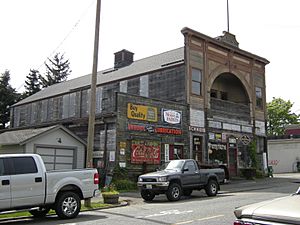
By the 1960s, parts of downtown Snohomish were getting old. The city looked into plans to make downtown new again. In 1973, the city created a 26-block historic district. This helped keep old buildings and encouraged new ones to match the historic style. The Snohomish Historic Business District was added to the National Register of Historic Places in 1974. Larger stores moved to newer areas outside of First Street.
In 1974, a mill in Snohomish burned down but was rebuilt. In 1975, a bad flood damaged over 300 homes. In 1985, U.S. Route 2 was changed to go around Snohomish. This helped reduce traffic in downtown. In the 1990s, First Street was improved to attract tourists. Sidewalks were rebuilt, and public restrooms were added.
Geography and Nature
Snohomish is located on the north side of the Snohomish River. The Pilchuck River joins the Snohomish River nearby. The city sits on Getchell Hill Plateau, a small hill in the river valley. Some parts of the city are on a ridge west of the Pilchuck River. Blackmans Lake is north of downtown Snohomish. It has a boat launch for public use. The river valley was formed about 14,000 years ago by a melting glacier. The river sometimes floods in winter, which can affect downtown.
The city covers about 3.60 square miles (9.32 square kilometers). Most of this area is land, with a small part being water. Snohomish's city limits are generally the Snohomish River to the south. Fobes Hill is to the west, and the Pilchuck River is to the east. The city also has an area planned for future growth. This area extends north towards U.S. Route 2 and south of the Snohomish River. It includes Harvey Airfield.
The historic downtown area and old homes make up the Snohomish Historic District. Many houses have plaques showing when they were built and who first lived there. The city offers tours of these historic homes each year. One of them, the Blackman House, is a museum open all year.
People of Snohomish (Demographics)
| Historical population | |||
|---|---|---|---|
| Census | Pop. | %± | |
| 1880 | 149 | — | |
| 1890 | 1,903 | 1,177.2% | |
| 1900 | 2,101 | 10.4% | |
| 1910 | 3,244 | 54.4% | |
| 1920 | 2,985 | −8.0% | |
| 1930 | 2,688 | −9.9% | |
| 1940 | 2,794 | 3.9% | |
| 1950 | 3,094 | 10.7% | |
| 1960 | 3,894 | 25.9% | |
| 1970 | 5,174 | 32.9% | |
| 1980 | 5,294 | 2.3% | |
| 1990 | 6,499 | 22.8% | |
| 2000 | 8,494 | 30.7% | |
| 2010 | 9,098 | 7.1% | |
| 2020 | 10,126 | 11.3% | |
| 2022 (est.) | 10,150 | 11.6% | |
| U.S. Decennial Census | |||
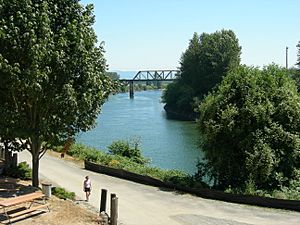
2020 Census Information
According to the 2020 U.S. census, Snohomish had 10,126 people. There were 4,221 households in the city. The city had about 2,876 people per square mile. Most residents (88.0%) were White. About 3.2% were Asian, and 0.5% were Native American. People of Hispanic or Latino background made up 5.6% of the population.
The average age in the city was 38.0 years old. About 22.5% of residents were under 18. About 17.1% were 65 or older. The city's population was 45.5% male and 54.5% female. The average household income was $70,234. About 8.0% of the people lived below the poverty line.
2010 Census Information
In the 2010 U.S. census, Snohomish had 9,098 people. There were 3,645 households. The population density was about 2,645 people per square mile. Most residents (89.0%) were White. About 2.1% were Asian, and 1.1% were Native American. Hispanic or Latino people made up 8.0% of the population.
About 34.8% of households had children under 18. The average household had 2.41 people. The average age in the city was 37.8 years. About 24.3% of residents were under 18. About 11.7% were 65 or older. The city's population was 48.2% male and 51.8% female.
City Government
Snohomish is a code city with a strong mayor–council government. This means it has an elected mayor and an elected city council. Seven city council members are chosen by all voters. They serve four-year terms. The city used to have a different government system. But in 2017, voters chose to go back to the mayor–council system. Linda Redmon was elected mayor in 2021.
The city government has 50 full-time employees. It had a budget of $22.7 million in 2016. The city is led by the city administrator, Heather Thomas, who started in 2022.
Snohomish is part of the 1st congressional district for federal elections. This district is represented by Democrat Suzan DelBene. For state elections, the city is in the 44th legislative district. Snohomish is also part of the Snohomish County Council's 5th district.
Parks and Fun Activities
The city government has nine developed parks. These parks cover 167 acres (68 hectares) and are used for public fun and nature. Some parks include Ferguson Park and Hill Park on Blackmans Lake. There are also Morgantown Park and Pilchuck Park on the Pilchuck River. Cady Park and KlaHaYa Park are in downtown on the Snohomish River. These parks have playgrounds, walking trails, picnic areas, boat launches, and sports fields. The city also owns the local Boys and Girls Club and senior center.
Snohomish is the start of the Centennial Trail. This is a long path for walking, biking, and horseback riding. It connects Snohomish to Lake Stevens and Arlington. The trail follows an old railroad line. The city also has its own paths for walking and biking.
The city has the Snohomish Aquatic Center, a public swimming pool complex. The Snohomish School District built it for high school swim teams. It opened in 2014 and cost $22.2 million. The city helped pay for it and offers discounts to residents.
Schools in Snohomish
The Snohomish School District runs public schools for Snohomish residents. It also serves nearby areas like Cathcart and Machias. As of 2020, the district had 9,421 students and 488 teachers. It has 18 schools in total. There are two main high schools: Snohomish High School and Glacier Peak High School. There is also an alternative high school program. These high schools get students from two middle schools, which get students from ten elementary schools.
The Snohomish area also has several private schools. These schools are run by churches and other groups. St. Michael Catholic Church opened its parish school in 2007. Other Christian schools include Lighthouse Christian Academy and Zion Lutheran School.
Culture and Events
Arts and Entertainment
The biggest place for performing arts in Snohomish is Tim Noah's Thumbnail Theater. It is a non-profit theater in a historic church. It started in 2003 and hosts plays, concerts, and improv comedy.
Some movies have been filmed in Snohomish. These include the 1981 movie Bustin' Loose and the 1985 movie Twice in a Lifetime. The city's high school was also a setting in the 1983 film WarGames.
Community Events
Snohomish hosts an annual summer festival called Kla Ha Ya Days. It started in 1913 and attracts up to 25,000 visitors. It is one of several local events connected to the larger regional Seafair celebration.
Local Media and Library
The city is part of the Seattle–Tacoma media area. It is served by a daily newspaper, The Everett Herald. A local weekly newspaper, the Snohomish County Tribune, is also published in Snohomish.
Snohomish's public library is part of Sno-Isle Libraries. This is a regional library system. The library building is 23,000 square feet (2,100 square meters). It is the third-largest in the Sno-Isle system. It opened in July 2003 and cost $8 million. It replaced an older Carnegie library building. The Snohomish library was named a favorite by book expert Nancy Pearl in 2008.
The city had Snohomish County's first lending library, started by citizens in 1876. A permanent library building, funded by Andrew Carnegie, opened in 1910. This building was used until 2003. It was then used for art exhibits and a community center. After a renovation, it reopened in 2021.
Sports in Snohomish
Snohomish has several semi-professional soccer teams. It also hosts big youth soccer tournaments at Stocker Fields. Snohomish Youth Soccer organizes these tournaments. They also run Snohomish United, a soccer team that plans to start in 2025. The Snohomish Sky team started in 2023. They have men's and women's teams. The Snohomish Soccer Dome is also used for practices by the Washington Wolfpack, an Arena Football League team from Everett.
Notable People from Snohomish
Snohomish has been home to many professional athletes. These include players in American football, baseball, basketball, and ice hockey.
- Earl Averill, professional baseball player and Baseball Hall of Fame member
- Earl Averill Jr., professional baseball player
- Lexi Bender, professional ice hockey player
- Kyle Bjornethun, professional soccer player
- Jon Brockman, professional basketball player
- Tom Cable, American football coach
- Adam Eaton, professional baseball player
- David Eddings, fantasy writer
- Emory C. Ferguson, co-founder of Snohomish
- Chelsey Glasson, user researcher and author
- Keith Gilbertson, American football player and coach
- Roy Grover, professional baseball player
- Larry Gunselman, NASCAR driver
- Kevin Hamlin, NASCAR driver
- Richard Harriman, NASCAR driver
- Bret Ingalls, American football coach
- Curt Marsh, professional American football player
- Finn McKenty, YouTuber
- Jesper Myrfors, card game art director
- Jeff Ogden, professional American football player
- Jim Ollom, professional baseball player
- John Patric, author and journalist
- Don Poier, sports announcer
- Chris Reykdal, elected official
- Doug Roulstone, Navy officer and state representative
- Chrissy Teigen, author and professional model
- Karen Thorndike, sailor
- Earl Torgeson, professional baseball player
- Willis Tucker, journalist and county executive
- Hal Uderitz, professional soccer player
- Josh Vanlandingham, professional basketball player
- Fred W. Vetter Jr., Air Force brigadier general
- Brooke Whitney, professional ice hockey player
City Infrastructure
Getting Around (Transportation)
Snohomish is crossed by two main highways. U.S. Route 2 goes around the city to the north and east. It continues to Everett and Stevens Pass. State Route 9 runs north and south. It connects to Woodinville and Lake Stevens. Other important roads include Bickford Avenue and 2nd Street.
Community Transit provides bus service in Snohomish. Buses travel from Everett Station to Snohomish. They continue east along US 2 to Monroe and other towns. Another route connects Snohomish to Lynnwood and Mill Creek. Community Transit also has a bus route that goes from Snohomish to Downtown Seattle. The city has one park and ride lot near Avenue D and State Route 9.
A privately owned airport, Harvey Airfield, is south of downtown Snohomish. It opened in 1944. The airport is used for private planes and small businesses. These include skydiving clubs and hot air balloon operators.
City Services (Utilities)
Different companies provide utility services in Snohomish. The Snohomish County Public Utility District provides electric power. Puget Sound Energy supplies natural gas. The city government works with Republic Services for garbage, recycling, and yard waste collection. Garbage is sent to a landfill in Roosevelt.
The city government manages tap water service. The city buys most of its water from the City of Everett. This water comes from Spada Lake. The rest of the water comes from the Snohomish County Public Utility District. The city used to have its own water treatment plant. But it was too expensive to keep up.
Snohomish has a wastewater system. Downtown and older areas have a combined system for sewage and stormwater. Newer parts of the city have separate systems. The city's wastewater treatment plant on the Snohomish River was updated.
Health Care Services
The closest general hospital to Snohomish is EvergreenHealth Monroe. This hospital serves Snohomish and nearby areas. Snohomish also has several general and special clinics. These include clinics managed by Providence Health & Services and The Everett Clinic.
See also
 In Spanish: Snohomish (Washington) para niños
In Spanish: Snohomish (Washington) para niños


